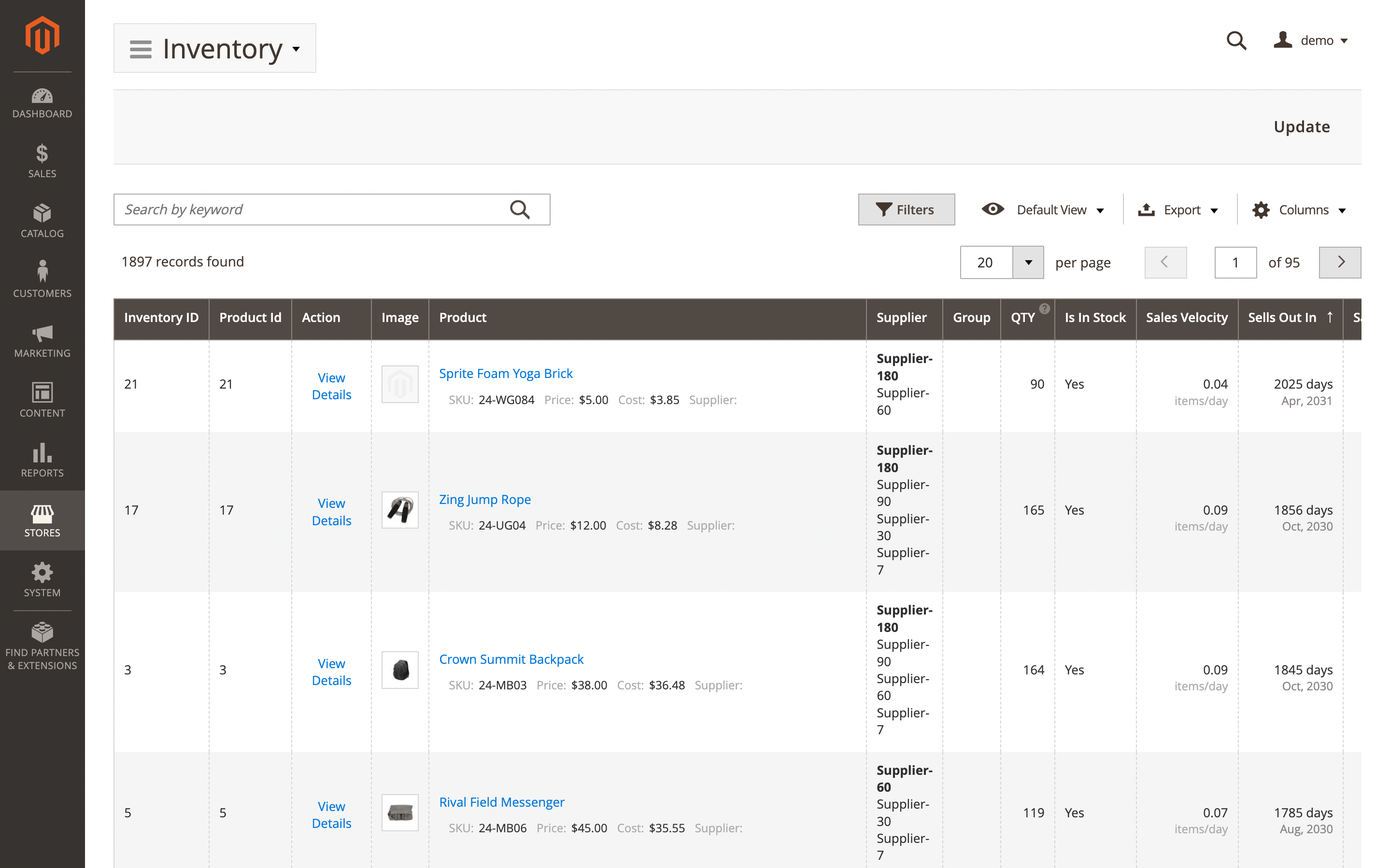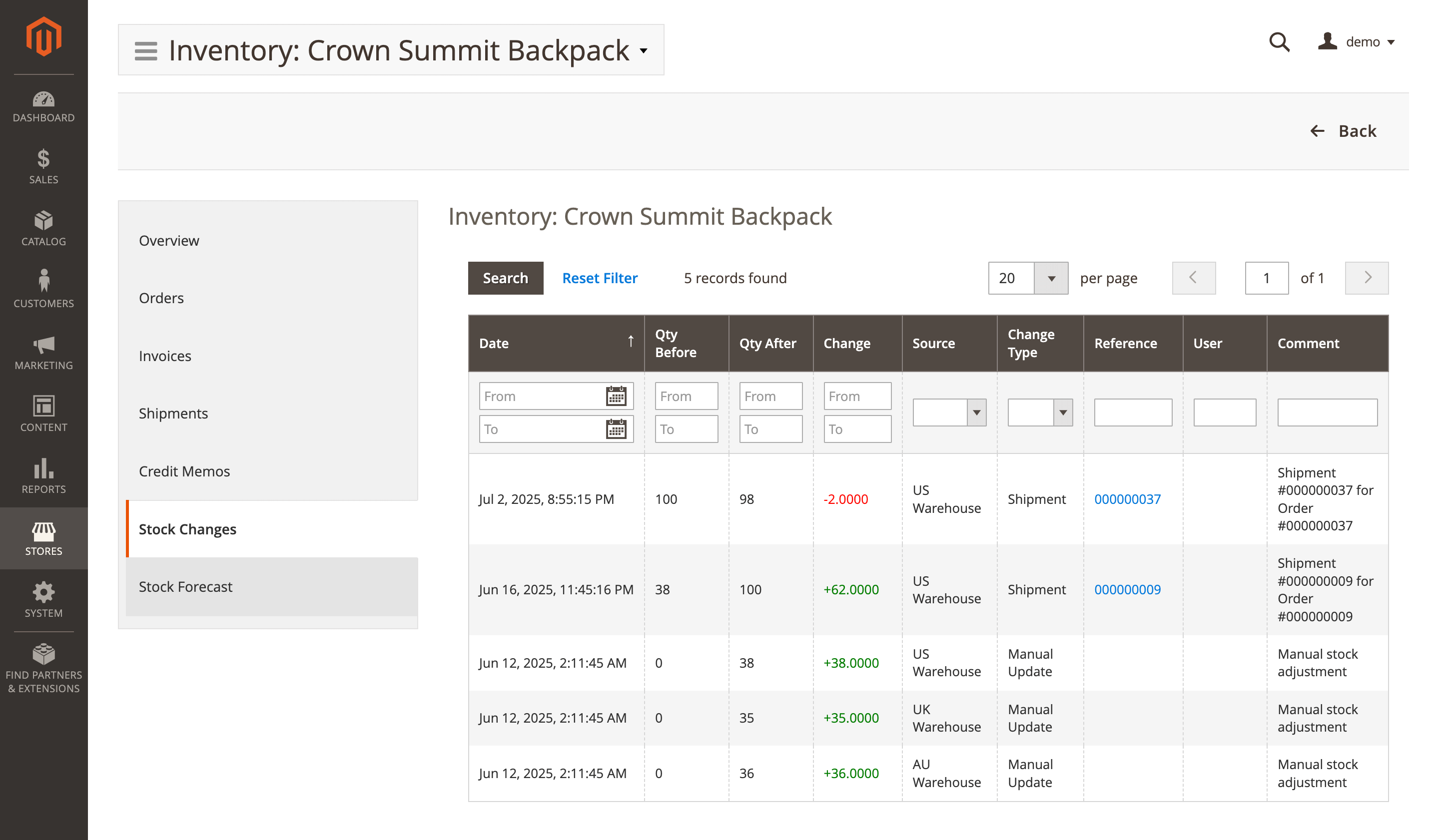Inventory
This page shows current on-hand and salable quantities by source (warehouse/store), along with incoming stock. Use it to track availability, spot stockouts or overstock, and plan replenishment.
Inventory list
Navigate to Stores -> Inventory Planner -> Inventory to access to view the full list.

Here, you'll find two groups of fields: default product attributes and attributes added by the extension.
- Product ID: internal numeric identifier for the product.
- Product: product name and SKU.
- Image: product thumbnail.
- Other default product attributes that can be managed via the Columns dropdown (e.g., SKU, price, status).
- Inventory ID: unique identifier of the inventory record.
- Action: quick actions (view, edit, etc.).
- Supplier: primary vendor for this product.
- Group: planning or merchandising group/tag used for reporting.
- Qty: actual on-hand quantity across all stocks/sources.
- Is in stock: stock status.
- Yes: product is available for sale.
- No: product is not available for sale.
- Sales velocity: average units sold per day.
- Sells out in: projected days until stockout at current sales velocity.
- Saleable qty: quantity available to sell after reservations.
- Replenishment qty: suggested order quantity to meet targets.
- Replenishment in: estimated days until replenishment is required.
- Overstock quantity: units above the overstock threshold.
- Last sold at: date/time of the most recent sale.
- 7 days sales: units sold in the last 7 days.
- 30 days sales: units sold in the last 30 days.
- 90 days sales: units sold in the last 90 days.
- Total sales: cumulative units sold to date.
- Lead time: average supplier lead time in days.
- Quantity at each warehouse: on-hand quantity broken down by source/warehouse.
- Saleable qty at each warehouse: sellable quantity by source/warehouse.
- Days of stock: estimated days the current stock will last at the current sales velocity.
Use the Update button (top-right) to refresh all data immediately.
Inventory item details
Use the View details option in the Action column to view details of a specific record. Next data will be available.

Overview
Show the summary snapshot of product key stock metrics.
- Product information: core identifiers and product state.
- Sku: unique product code (stock keeping unit).
- Name: title displayed on the storefront and in admin.
- Type: product kind (simple, configurable, bundle, etc.).
- Status: catalog state (enabled/disabled).
- Inventory status: overview of on-hand, salable quantity, and stock state.
- Qty: on-hand units across all sources.
- Saleable qty: units available to sell after reservations.
- Status: in/out of stock indicator.
- Sales analytics: recent sales, pace, and depletion estimates.
- Last 7 days sales: units sold in the past 7 days.
- Last 30 days sales: units sold in the past 30 days.
- Last 90 days sales: units sold in the past 90 days.
- Average daily sales: average units sold per day.
- Estimated days until out of stock: projected days until inventory reaches zero.
- Sales velocity: current sales rate (units per day).
Orders
Lists customer orders containing this product. The table includes:
- Order #: unique order identifier.
- Date: order creation date.
- Qty ordered: total units ordered.
- Order status: current fulfillment/payment state.
Invoices
Shows billed items and amounts for completed or partially completed orders, useful for revenue tracking vs stock movement. The table includes:
- Invoice #: unique invoice identifier.
- Order #: related order identifier.
- Date: invoice creation date.
- Qty invoiced: total units billed on this invoice.
- Order status: current status of the linked order.
Shipments
Displays items shipped to customers, reflecting inventory decreases and delivery status. The table includes:
- Shipment #: unique shipment identifier.
- Order #: related order identifier.
- Date: shipment creation date.
- Qty shipped: total units dispatched in this shipment.
- Order status: current status of the linked order.
Credit memos
Records returns and refunds that may add items back to stock or adjust financials. The table includes:
- Credit memo: unique credit memo identifier.
- Order: related order identifier.
- Date: credit memo creation date.
- Qty refunded: total units refunded on this credit memo.
- Order status: current status of the linked order.
Stock changes
Audit trail of inventory adjustments—receipts, transfers, corrections—with who/when/what changed. The table includes:
- Date: timestamp of the adjustment.
- Qty before: on-hand quantity before the change.
- Qty after: on-hand quantity after the change.
- Change: delta between after and before quantities.
- Source: warehouse/source affected.
- Change type: reason or operation (shipment, manual update, etc.).
- Reference: related document (order, shipment, etc.).
- User: user who made the change.
- Comment: optional note explaining the adjustment.
Stock forecast
Projected demand, days to stockout, and recommended replenishment based on sales history, lead time, and service targets. Next data available:
- Recommended reorder date: suggested date to place the next purchase order.
- Recommended order quantity: suggested number of units to order.
- Period: forecast window used for projections.
- Projected sales: expected units to be sold during the period.
- Remaining stock: on-hand units expected at period end.
- Status: readiness indicator.